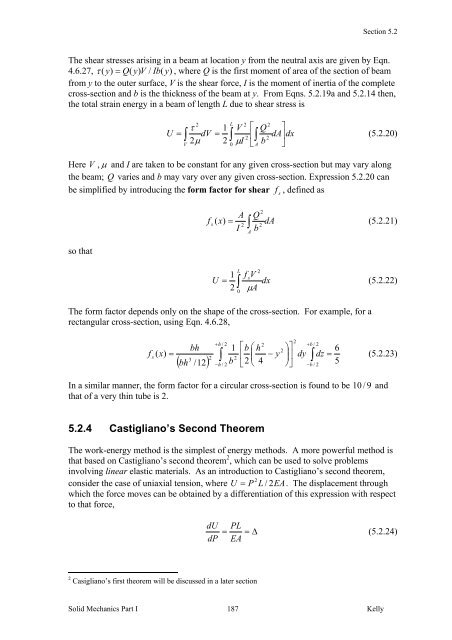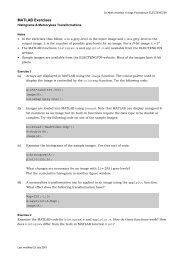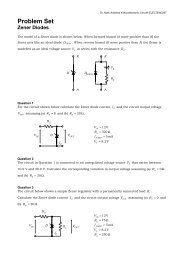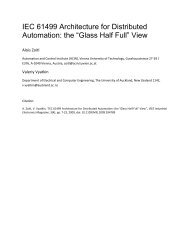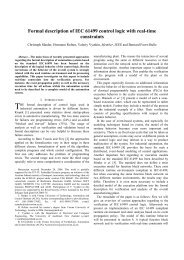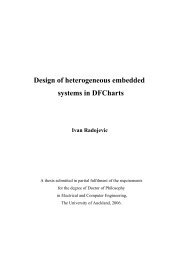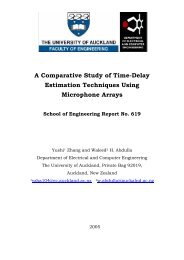5.2 Elastic Strain Energy
5.2 Elastic Strain Energy
5.2 Elastic Strain Energy
Create successful ePaper yourself
Turn your PDF publications into a flip-book with our unique Google optimized e-Paper software.
Section <strong>5.2</strong><br />
The shear stresses arising in a beam at location y from the neutral axis are given by Eqn.<br />
4.6.27, τ ( y ) = Q(<br />
y)<br />
V / Ib(<br />
y)<br />
, where Q is the first moment of area of the section of beam<br />
from y to the outer surface, V is the shear force, I is the moment of inertia of the complete<br />
cross-section and b is the thickness of the beam at y. From Eqns. <strong>5.2</strong>.19a and <strong>5.2</strong>.14 then,<br />
the total strain energy in a beam of length L due to shear stress is<br />
2<br />
L 2 2<br />
τ 1 V ⎡ Q ⎤<br />
U = ∫ dV = ∫ ⎢ dA⎥dx<br />
2<br />
V<br />
I ∫ 2<br />
2μ 2 0 μ ⎣ A b ⎦<br />
Solid Mechanics Part I 187<br />
Kelly<br />
(<strong>5.2</strong>.20)<br />
Here V , μ and I are taken to be constant for any given cross-section but may vary along<br />
the beam; Q varies and b may vary over any given cross-section. Expression <strong>5.2</strong>.20 can<br />
be simplified by introducing the form factor for shear f s , defined as<br />
so that<br />
2<br />
A Q<br />
f s ( x)<br />
= dA<br />
2<br />
I ∫<br />
(<strong>5.2</strong>.21)<br />
2<br />
b<br />
U<br />
The form factor depends only on the shape of the cross-section. For example, for a<br />
rectangular cross-section, using Eqn. 4.6.28,<br />
=<br />
1<br />
2<br />
L<br />
∫<br />
0<br />
A<br />
f V<br />
s<br />
2<br />
μA<br />
dx<br />
2<br />
3 2<br />
( / 12)<br />
∫ 2 ⎢<br />
2 ⎜ − y ⎥ =<br />
4 ⎟ dy dz<br />
bh<br />
5<br />
−h<br />
/ 2 b ⎣ ⎝ ⎠⎦<br />
−b<br />
/ 2<br />
(<strong>5.2</strong>.22)<br />
+ h / 2<br />
2<br />
+ b / 2<br />
bh 1 ⎡b<br />
⎛ h ⎞⎤<br />
6<br />
f s ( x)<br />
= ∫<br />
(<strong>5.2</strong>.23)<br />
In a similar manner, the form factor for a circular cross-section is found to be 10 / 9 and<br />
that of a very thin tube is 2.<br />
<strong>5.2</strong>.4 Castigliano’s Second Theorem<br />
The work-energy method is the simplest of energy methods. A more powerful method is<br />
that based on Castigliano’s second theorem 2 , which can be used to solve problems<br />
involving linear elastic materials. As an introduction to Castigliano’s second theorem,<br />
2<br />
consider the case of uniaxial tension, where U = P L / 2EA.<br />
The displacement through<br />
which the force moves can be obtained by a differentiation of this expression with respect<br />
to that force,<br />
dU<br />
dP<br />
PL<br />
=<br />
EA<br />
= Δ<br />
2 Casigliano’s first theorem will be discussed in a later section<br />
2<br />
(<strong>5.2</strong>.24)


